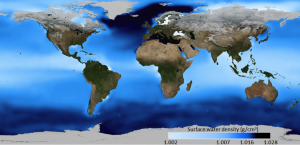Chapter 18 Geology of the Oceans
Chapter 18 Summary
The topics covered in this chapter can be summarized as follows:
| 18.1 | The Topography of the Sea Floor | The oceans are about 4,000 m deep on average, but they also have a wide range of topographical features, including shallow continental shelves, continental slopes, continuous ridges related to plate divergence, numerous isolated seamounts, and deep submarine canyons at subduction zones. |
|---|---|---|
| 18.2 | The Geology of the Oceanic Crust | Most oceanic crust forms during sea-floor spreading and is characterized by pillow basalts, sheeted dykes, gabbro bodies, layered gabbro, and layered ultramafic rock. The oldest parts of the sea floor are older than 200 Ma, but most of the sea floor is younger than 100 Ma. Seamounts are common and almost all are volcanoes, related to mantle plumes, subduction, or other processes. In tropical regions, ocean islands tend to be surrounded by carbonate reefs. |
| 18.3 | Sea-Floor Sediments | Almost all of the sea floor is covered by young sediments and sedimentary rocks, derived either from erosion of continents or from marine biological processes. Clastic sediments, some quite coarse, predominate on shelves and slopes. Terrigenous clays are distributed across the sea floor, but in areas where either carbonate- or silica-forming organisms thrive, the sediments are likely to be dominated by carbonate or silica oozes. Methane hydrates, derived from bacterial decomposition of organic matter, form within sediments on shelves and slopes. |
| 18.4 | Ocean Water | Average ocean water has about 35 g/L of salt, mostly made up of chlorine and sodium, but also including magnesium, sulphur, and calcium. Salinity levels are highest in the tropics where evaporation is greatest. Sea-surface temperatures range from less than 0°C at the poles to over 25°C in equatorial regions. Open-ocean currents, which generally rotate clockwise in the northern hemisphere and counter-clockwise in the south, are critically important in redistributing heat on Earth. Deep-ocean currents, driven by density differences, are another key part of the heat redistribution system. Changes to current patterns or intensity have significant implications for global climate. |
Questions for Review
1. What is the origin of the sediments that make up continental shelves? Why are the shelves on the eastern coast of North America so much wider than those along the west coast?
2. The ocean trenches at some subduction zones are relatively shallow. What is one explanation for this?
3. What are the main lithological components of oceanic crust, and how does this rock form?
4. Referring to Figure 18.7, determine the age of the oldest sea floor in the Indian Ocean.
5. Explain why relatively coarse terrigenous sediments (e.g., sand) tend to accumulate close to the continents, while terrigenous clay is dispersed all across the ocean floor.
6. Although clay is widely dispersed in the oceans, in some areas, deep-sea sediments are dominated by clay, while in others they are dominated by carbonate or silica ooze. Why do these differences exist?
7. Explain why carbonate sediments are absent from the deepest parts of the oceans.
8. What is the source of the carbon that is present in sea-floor methane hydrate deposits?
9. Where are the saltiest parts of the oceans? Why?
10. Explain why sea-surface water with the greatest density is found in the north Atlantic, as shown on this map.
[SE after: https://upload.wikimedia.org/wikipedia/en/3/31/SeaSurfaceDensity.jpg]
11. What type of ocean currents result from the relatively dense water in the north Atlantic?
12. How do the open-ocean currents affect the overall climate patterns on Earth?


